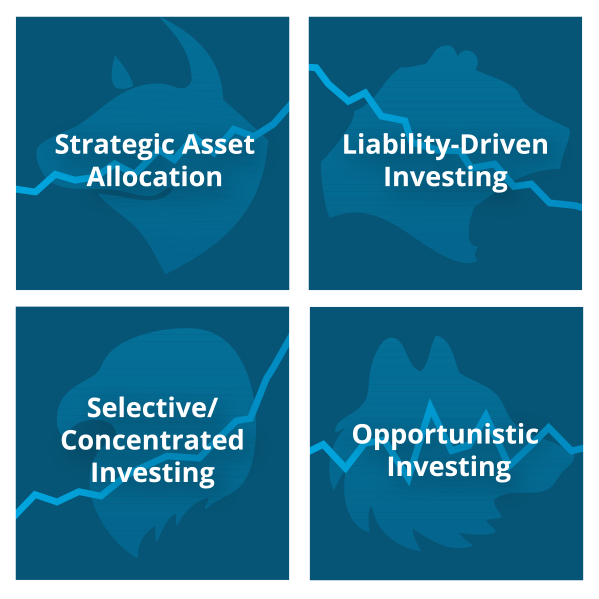
The investing public generally makes very little distinction between investment planning and investment plan implementation. In most cases investors will simply skip the former altogether, moving directly to the investment of assets with whomever they believe is the best money manager, mutual fund, stock, bond, or other vehicle available. They will later find out that this has been a dire mistake. Many investors are coming to this unpleasant realization as we speak. The contemporary markets have not been kind to investors in general, and have relentlessly beaten down the assets of those who have not done the proper investment planning.
To the general public, the difference between an investment plan and the implementation of an investment plan is unclear, and this is part of the reason that so many have neglected it. For illustrative purposes, we will provide an examination of these differences:
Investment planning:
Investment planning is generally done as a component of the comprehensive financial planning process, but can also be performed on a stand-alone basis. A comprehensive financial plan will incorporate items such as the creation of trusts and gifting arrangements for estate plans, the institution of buy-sell agreements for business succession planning, and the appropriation of benefits for employers/employees, amongst many other considerations. An investment plan is often one of such considerations. Optimally, it will be designed to mesh with the other components of the comprehensive financial plan.
The investment plan will consider the other financial plan components and define the proper course of action for a client in the allocation of their existing assets and liabilities towards the achievement of their financial and life objectives.
These objectives may be in the context of financial independence or retirement planning, accumulation goal planning, distribution management, business risk management, individual estate transfer, business project financing, etc. The plan will define items such as the periodic investments over a given time horizon expected as necessary for the achievement of a given goal, or the expected available distribution from a pool of assets on a conservative, moderate, or aggressive basis.
Quite importantly, while the plan may be designed to achieve a certain goal, or more likely a whole set of client goals, its true merit rests not in a projection of what we believe will occur in the future, but in the management of the risks associated with the potential achievement of those goals. Effective investment planning is centered on the management of risks.
Investment plans may include the use of various tools that fall outside what are typically considered “investments” by the public (Not just stocks, bonds, real estate, etc).
Many of these tools are designed to address specific risks or goals in a structured manner. These tools may include money management programs, annuities, structured products, insurances, futures, options, and other derivatives, amongst a milieu of alternative solutions. The investment plan will most often define the appropriate use of such tools, the investment vehicles needed, the proper IRS account classification (ie. IRA, 529 Plan, Non-Qual Deferred Comp, 401K, 831(b), etc.), and the proper asset split or asset allocation within each of the new or existing accounts in question.
Remember that during this planning, there may be no mention of which specific branded products, portfolio managers, stocks, bonds, or other issues will be used. The specific investment and security selections are all reserved for the investment plan implementation process.
Investment implementation:
Most investors completely skip everything discussed in the investment planning section above. They will typically move straight to investment implementation without ever having developed a coherent plan. To compound this problem, without qualified professional guidance, the investment is usually done very poorly. A poor strategy would involve first, the recognition that a sum of money needs to be invested (often with no purpose in mind); finding an advisor or money manager to professionally manage it (often this is skipped as well); and selecting what the investor believes is the “best” investment (A determination usually made based on a short term prediction/bet, or seeking the highest available current rate of return).
The mentality associated with this type of investing is developed primarily through a lack of knowledge with regards to investment planning theory and the availability of commensurate services in this regard, as well as a US investment industry history that has been dominated by the traditional stockbroker, who is motivated primarily by the execution of transactions, whether or not they fit the investment plans of the client or are in the client’s best interests.
Now that we’ve defined poor investment implementation, let’s consider proper investment plan implementation.
An effective process involves first, a full review and understanding of a client’s pre-determined investment plan objectives and implementation guidelines.
In recognition of these, the implementer will research various options for implementation of each plan component, including any additional professionals needed, appropriate money management firms, branded risk management products and investment platforms, and in some cases, the individual securities that will be used to flesh out a predetermined asset allocation (Assuming this will not be left up to a third party money manager).
For each client objective outlined in the investment plan, an appropriate solution or several solutions must be researched, with recommendations made on which the client should utilize. For example, a client may have a retirement investment objective for which three accounts, tax-deferred and taxable, are available for investment. An investment policy statement with an appropriate strategic asset allocation adjusted for client risk tolerance and investment objective time horizon may have been created for the objective as a whole, with the intention of spreading a retirement accumulation portfolio across the three available asset-holding accounts (each of a different IRS classification). Part of the implementation process will be to select appropriate asset managers, strategies, or securities components to fill out the asset allocation and purchase these components, each in the appropriate one of the three available accounts to maximize tax efficiency for the client.
A similar process involving the appropriate available solutions will occur with each of the client’s investment plan objectives. Each investment plan objective may have its own time horizon, accumulation/distribution objective, account type, etc, and as such, will require a distinct portfolio implementation.
In summary, investment plan implementation involves doing the research and due diligence necessary to achieve the most favorable execution of a pre-designed client investment plan. It does not involve catering to the more common thought processes of “I have some money to invest, so where should I put it?”, or “What kind of rate of return can I get?”, or “What are some good stocks to invest in?.” Jumping to cater directly to this type of behavior is generally counterproductive for clients.
Two Schools of Thought:
Asset/Liability Matching and Overall Client Portfolio Diversification
There are generally two schools of thought when it comes to investment planning. One of these focuses on matching assets with liabilities, while the other focuses purely on the broad diversification of a client’s overall portfolio. Both of these schools have merits, but by themselves, they are insufficient. Optimality requires that multi-disciplinary investment planners use both of these concepts in order to efficiently manage a client’s overall risk and heighten the probability that investment objectives will be achieved. Let’s look at each of these concepts individually, and then we will see how they can be utilized together both to develop an investment plan and to implement it for clients.
Overall Client Portfolio Diversification:
This thought school states that the best way to manage risk is to focus on lowering the average volatility in the returns of a client’s entire investable asset portfolio. The client’s portfolio is generally treated as a single whole, and the primary risk that is managed is that of portfolio volatility. Such volatility is managed by the inclusion of various non-correlated assets across all available investment accounts. The idea is to minimize volatility while targeting a given long term rate of return in an effort to reduce the risk that when a client unexpectedly needs to access his/her assets they will not be there to access or will be there at a significantly reduced value. This methodology is traditionally most often applied to individual client accounts.
The methodology is optimally used for a client that has a large pool of assets for which there is no specific determinable future use (ie. The client can’t decide what they will use their assets for), or for which all of the client’s assets are intended for the same investment objective (ie. All of the client’s assets will definitely be used to purchase a future home). It may also be used for a client who has no significant concentrated risks or liabilities. The problem is that in reality, there are very few investors for whom one of these scenarios will apply perfectly to their long term financial situation.
Asset/ Liability Matching:
This school of thought comes from direct hedging or insuring. It is traditionally most often applied to institutional client investment objectives. The idea behind it is that for a definitive investment objective in which parameters are known, one can use an appropriately structured tool to directly hedge the risk that an event will occur (usually at a nominal cost to do so). By using this methodology, one can mostly or completely eliminate the negative consequences associated with the risk.
This methodology is optimally used for a client that has very well-defined investment objectives (“I want this account to be directly tied to inflation over a ten year time horizon for real return purposes, regardless of whether I lose nominal value in my account”), or that has significant concentrated risks (“I need to hedge against the risk of a decline in the price of soybeans for the next six months”), or well-defined liabilities (I have issued a note that has to be paid off in 8 years and the interest rate is tied to LIBOR).
In addition, ample assets to fund the asset/liability matching plan must also be available – an important consideration for the individual investor.
Again, most individual clients do not have all of their investment objectives focused in this category, and thus the methodology will not apply to all of their assets.
Putting it all together: Asset/Liability Matching in combination with Portfolio diversification
Let’s look at an example of how a very simple investment plan that utilizes both asset/liability matching and portfolio diversification might work specifically within the context of an individual’s retirement accumulation objective.
In such a plan, an advisor will aid the client in determining what their current retirement plan (incorporating all available client assets and liabilities) is expected to achieve in terms of a projected future value. A discussion and analysis will follow to determine whether the current projection is sufficient to provide the client’s family with the standard of living that they would like to maintain in retirement. In addition, all possible known risks to the achievement of that retirement goal will be considered.
The plan will be designed to minimize the risks to goal achievement, such as insufficient portfolio accumulation, disability, premature death, longer-than-expected lifespan,business liabilities, job loss, forced early retirement, market volatility, catastrophic (high order event) risk, financial systemic risk, etc. These last two are items that previous generations may have neglected in retirement planning, but have quickly become extremely important.
The actual delivered plan will often include recommendations such as the reallocation of existing assets into alternative account types, risk management tools, and investment vehicles. For example, a client’s retirement objectives may require a guaranteed minimum income of a certain inflation adjusted dollar amount, which will require the investment of a predetermined percentage of his/her overall portfolio into a defined benefit pension program (for business owners) or a variable annuity with income guarantee riders (often for individual investors). Such implementation would generally be considered asset/liability matching.
A portion of the same client’s portfolio may be invested on an institutional-style basis in a fully diversified portfolio of mutual funds and/or separately managed accounts adjusted for client risk tolerance and time horizon. The intention for this portion would be to achieve maximum asset growth while minimizing portfolio volatility in the time before retirement in case the assets need to be accessed. This is generally associated with the portfolio diversification school of thought.
In addition, a portion of the client’s retirement assets may be allocated to an alternative-style concentrated long term alpha-seeking portfolio, or perhaps a very small portion may be allocated to a speculative or opportunistic account. Depending on the intentions surrounding these, they could fall under both the asset/liability matching and portfolio diversification categories. They may be considered portfolio diversification because if they are intended to provide non-correlated asset returns and investment philosophy diversification, while they may be considered asset/liability matching in that they are intended to provide for a certain objective in retirement, such as a travel and leisure fund. Within each of these smaller portfolios, an appropriate asset allocation and/or investment policy statement must be determined.
Additional retirement plan risk management suggestions such as the funding of a disability insurance or life insurance policy may also be recommended. The disability policy would directly address the retirement risk associated with the inability to earn income, whereas the life insurance policy would directly address the risk associated with a lack of income to the surviving family in the event of death prior to retirement. Each of these would generally be considered asset/ liability matching. In addition, items such as a non-diversified fixed income portfolio of inflation protected securities for a retirement capital preservation objective might be considered asset/liability matching. All of the above-mentioned items might fall within the context of a retirement plan.
An interesting point is that certain investment styles inherently blend asset/liability matching and portfolio diversification. This is especially true of Institutional-style investing (or pure Modern Portfolio Theory investing). This style is usually used for the underlying portfolios of institutions such as insurance companies. In this instance, a life insurance company may hold a large portfolio of laddered and diversified fixed income securities which make up its reserves against the risks associated with insurance claims. This is a form of matching available assets with liabilities. The remainder of the available assets will then be invested in a diversified portfolio of equities, real assets, and alternative investments over an infinite time horizon. This is a very effective hybrid strategy for institutions. Wherever possible, we as advisors should attempt to follow a similar path for our individual clients, although a direct replication of this strategy is not always possible because of an individual client’s lack of both sufficient funds and an infinite time horizon.
Wherever possible, it is best to directly match assets with liabilities for risk management purposes...
It is important to note that the determination to use an asset/liability matching solution and/or a portfolio diversification solution is dependent on the certainty of the specific risks in question and the availability of products or vehicles to directly manage those risks. Wherever possible, it is best to directly match assets with liabilities for risk management purposes (although consideration must be paid to the credit of the product/security issuer). However, for those objectives that have a higher degree of uncertainty as to time horizon and purpose, appropriate portfolio diversification is often the best solution. Another consideration should be that whereas asset/liability matching generally does not allow an investor to target a certain average rate of return, building an efficiently allocated portfolio is often better suited to this purpose, even though there is no certainty of achievement of such returns.
The unfortunate fact is that most investors will go through their entire lives without any exposure whatsoever to the investment planning considerations described above, often to the detriment of their financial livelihoods. With an eye to the changes in the economic and financial landscape we are witnessing around us, now is a more important time than ever to ensure that our clients are doing the proper planning.







Leave a Comment